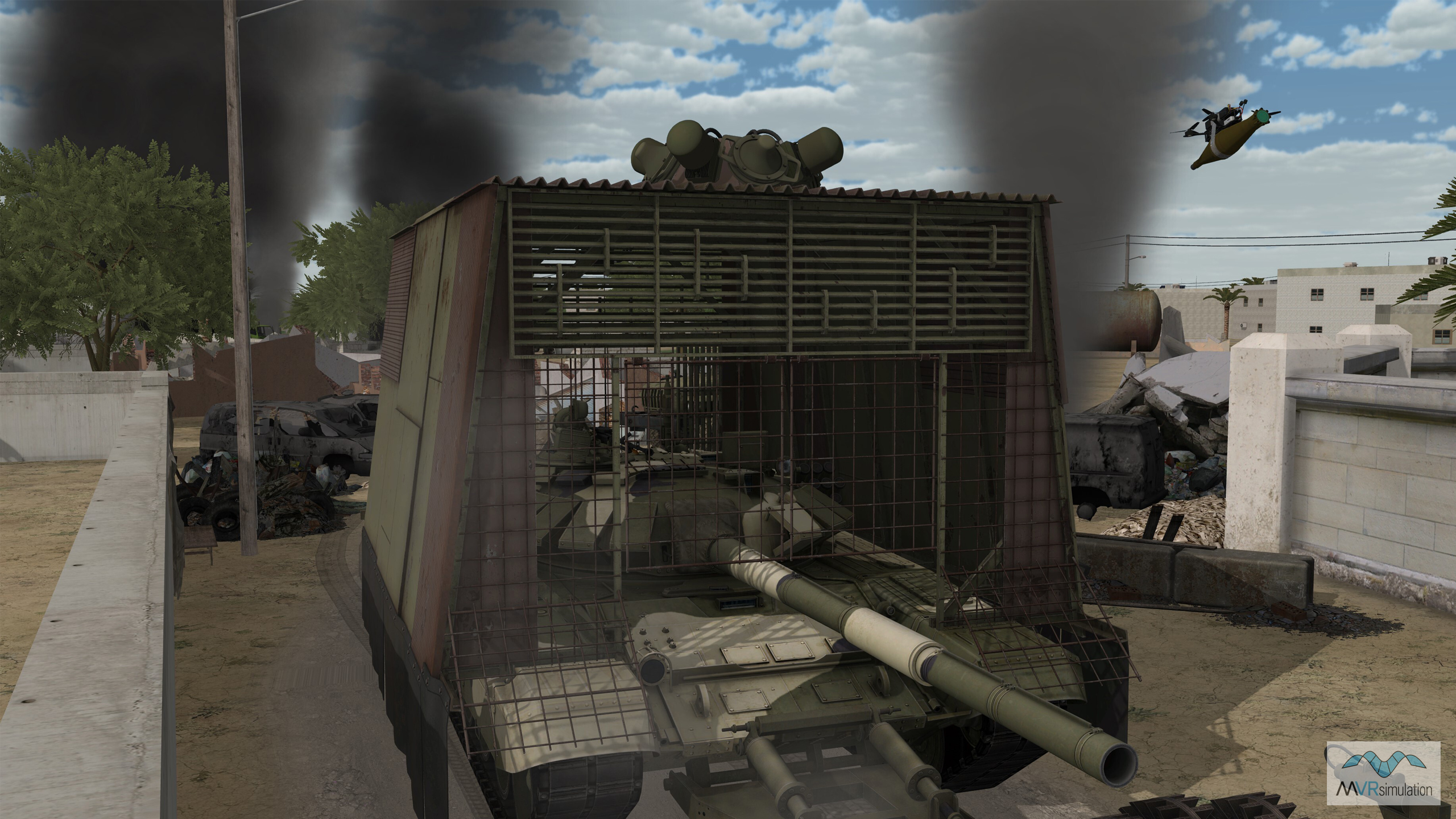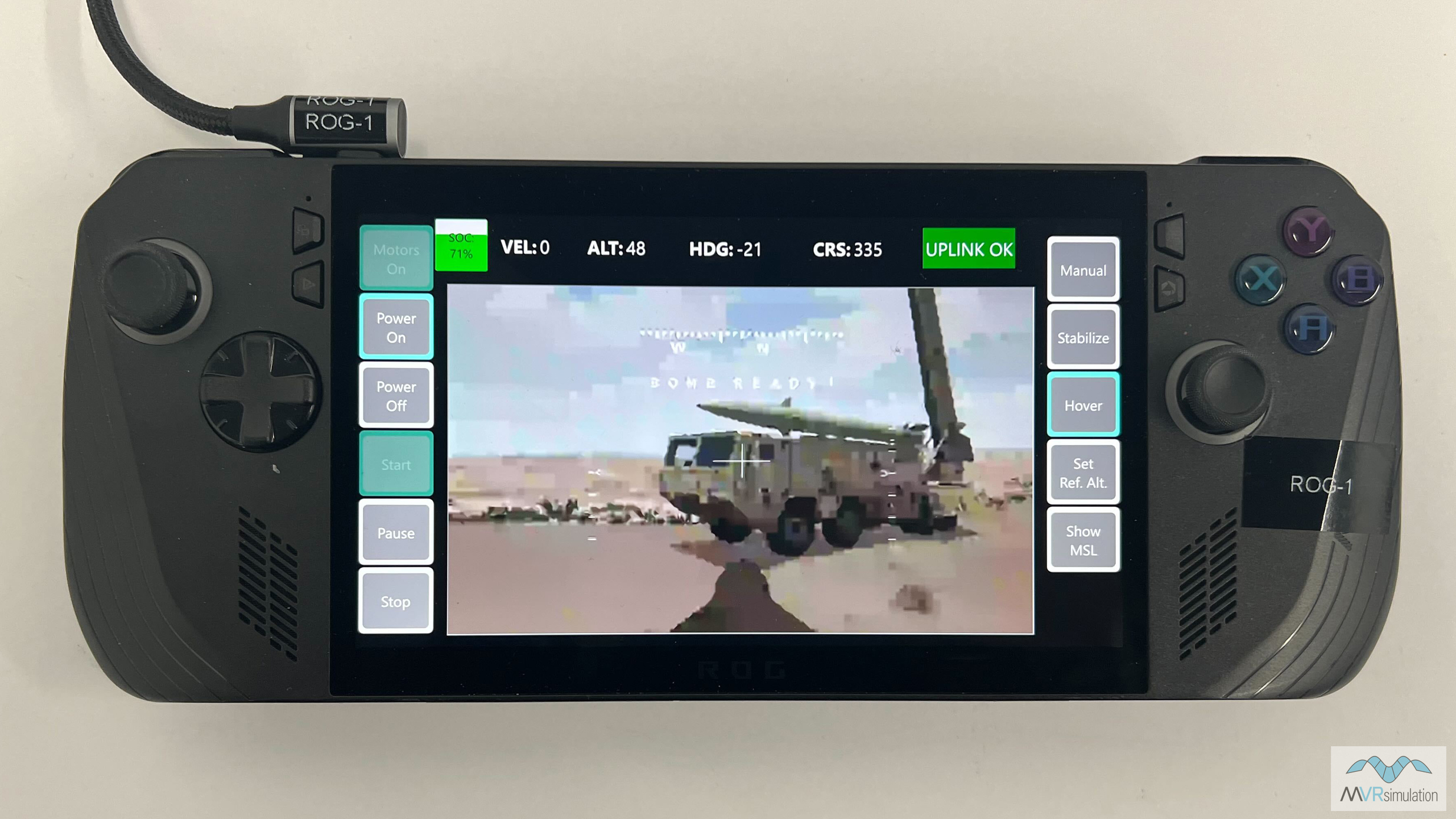First Person View UAV Simulator
MVRsimulation’s First Person View (FPV) UAV Simulator provides a highly-realistic training solution for the operation of racing-style quadcopter Small (s) UAS (sUAS), attack drones, and Purpose Built Attritable Systems (PBAS) on the contested battlefield. The internally-developed training system combines MVRsimulation’s Virtual Reality Scene Generator (VRSG) with a high-fidelity flight model from Bihrle Applied Research, to replicate the tactile, visual and cognitive demands of operating agile UAVs in combat to successfully defeat enemy targets. The FPV UAV Simulator can be used as an ultra-low footprint stand-alone training device for tactical operations, or networked with other in-use air and ground simulators that operate on VRSG infrastructure, enabling Large Scale Combat Operations (LSCO) training exercises.

The full FPV UAV Simulator includes laptop, handheld device, ATAK device, and 2D video display goggles.
Ultra-low footprint FPV UAV training
The highly-portable system consists of a high-end gaming notebook running VRSG and an ROG handheld controller device with configurable integrated pilot controls.
VRSG simulates the front-facing camera view of the UAV, streaming the operator's FPV to the handheld device. Training scenarios take place in VRSG's high-resolution geospecific terrain, which can be populated with real-time entities from VRSG’s 3D model library of 10,100+ currently-deployed military weapons and platforms.
The simulator is supplied with 2D video display goggles, allowing the UAV operator to experience the FPV camera as a head-mounted (non-tracking) view.

THE FPV UAV Simulator is an ultra-low footprint system consisting of a COTS handheld device and laptop running VRSG.

The handheld device shows the UAV's first person view of VRSG's high-res virtual terrain, with configurable integrated pilot controls.
Train to defeat ground targets
VRSG’s virtual world delivers a highly realistic environment in which users can train to acquire, identify, prioritize and defeat ground targets they will face in real-world operations
- Train to navigate visually in detailed terrain that closely replicates real-world locations using VRSG’s whole earth terrain with high-res insets
- Train to locate, identify and prioritize targets using VRSG’s continually-updated real-time 3D model library, including military platforms and weapon systems being deployed on battlefields worldwide, complete with articulated parts, damage states and advanced animations
- Create and edit real-time 3D scenarios to play back in VRSG: Use Scenario Editor's (included) game-level editor type interface to add culture and moving models directly to 3D terrain to create dense 3D scenes, and build pattern-of-life scenarios. Damage states for culture area handled in Scenario Editor as effects.
- Train for the real-world experience of operating in electronically denied and degraded environments: The VRSG stream can be downrated as the range of the UAV flight increases, and replicate the effects of counter-UAV devices such as EW jammers
- ATAK integration: VRSG’s ability to stream HD-quality H.264 video complete with KLV metadata allows VRSG to integrate with ATAK.

VRSG scene showing 3D model of the FPV UAV simulator entity approaching its target.

The first person camera view shows munition nose and UAV rotor blades for heightened realism.
FPV operators need to be able to train for scenarios where adversaries employ defensive Electronic Warfare (EW) systems. VRSG can be configured to intentionally degrade the simulated video stream from the aircraft to the operator in order to emulate the jamming of frequencies used by FPV video systems. The video below shows the increased difficulty of operating a FPV UAV in contested EW environments.
Train for integrated operations
In addition to providing a stand-alone, self-contained training solution, the FPV UAV Simulator can be networked with in-use air, ground and Joint Fires simulator systems in support of Large Scale Combat Operations (LSCO) training exercises in a shared virtual environment provided by VRSG. This includes systems that run on VRSG infrastructure, such as the U.S. Air Force MJAT program, MUSE/AFSERS, and other MVRsimulation simulators including the Deployable Joint Fires Trainer (DJFT) and Portable Joint Fires Trainer (PJFT).
VRSG supports distributed training exercises, providing the geospecific terrain in which training exercises take place. All users experience the same terrain and 3D real-time model entities, allowing users in networked simulators and dispersed locations to conduct collective training.
- Integrate with semi-automated forces (SAF) software and DIS traffic to see all platforms running on networked simulators as entities within the simulated battlefield;
- Stream KLV-embedded metadata video sensor feed to networked ATAK devices to share real-time rectified terrain with geolocated targets for increased situational awareness to all assets on the network;
- Appear to networked simulators as a real-time 3D model representative of a quadcopter UAV equipped with an RPG7 munition.

The VRSG video feed on the handheld device can be down-rated to mimic operations in EW contested environments.

The FPV UAV Simulator can be used with 2D display video goggles, or just the VRSG view on the handheld device.
ATAK integration
VRSG streams HD-quality H.264 video with embedded KLV metadata to produce a video stream that is MISB ST 0601.1/0601.9 compliant. ATAK devices receiving this simulated sensor video feed stream cannot discern it from real-world video feed rectify the simulated feed to real imagery of terrain:
- VRSG can determine the location of the UAV model in flight and display it on the map as an entity within the trainee’s ATAK device without the need for semi-automated forces software;
- A secondary downward-facing camera integrated into the FPV-UAV simulator can capture sensor imagery video and stream it to an ATAK device to produce a real-time moving map display that delivers situational awareness to operators at the tactical level, and to any other entity on the network.
Bihrle advanced flight model
Bihrle’s high-performance physics model is configured as a very lightweight quad-rotor racing drone UAV with front-facing FPV camera and attachable payload. It has been developed to replicate a high-performance UAV similar to those in active use on the modern battlefield.
The high-fidelity model is hosted in Bihrle's DSix simulation environment. The simulation employs a modular physics-based blade-element framework that has been used for full-scale rotorcraft training applications in Full Flight Simulators (FFS) and Flight Training Devices (FTD).
Flight model components include:
- Four independently-modeled prop-rotors featuring ground effect, inflow, and wake modeling and with accountability for atmospheric conditions;
- 6-degree-of-freedom aerodynamic model of airframe (chassis) and optionally attached payload;
- Comprehensive automatic flight control system emulation with rate-command, attitude-command, and groundspeed-command control modes (with expansion support for satellite navigation modes), with integrated avionics and IMU and support for drone startup procedures;
- Electronic speed controller (ESC) and individual motors for realistic rotor command response;
- Li-Poly battery model with accountability for electrical load profile and accurate energy density;
- Detailed mass properties model based on geometric configuration and specifically modeled drone components, including optionally attached configurable payload;
- Environmental modeling with user-configurable outside air temperature, steady and gusting wind speed and direction, and turbulence;
- Equations of motion with WGS84 global ellipsoid model configured for 1080 Hz integration step.
To replicate a high-performance racing drone, similar to those in active use on the modern battlefield, flight model specifications include:
- Airframe mass (without battery or payload installed): 0.61 kg
- Mass with default battery (1500 mAh Li-Poly): 0.85 kg
- Mass with default battery and payload (PG-7VL warhead): 3.05 kg
- COTS 3-blade propeller with 6” diameter at 4.5” blade-pitch, capable of thrust-to-weight ratios higher than 15:1 (for bare airframe)
- ESC and motors providing 30,000 RPM at maximum throttle
- User-configurable control sensitivity functions for each axis and flight control mode for accurate drone controller emulation
- Control response up to 360 deg/s in rate-command mode
- User-configurable battery pack size (with resulting mass changes) for selectable mission duration
- User-configurable FPV camera angle to suit the specific mission profile
- Selectable payload (e.g. PG-7VL warhead) with collision and detonation detection due to contact with scenery, terrain, or entities.
Flight Model Configuration Options
The FPV UAV Simulator can be configured in two ways: as a FPV one way attack UAV with attached RPG-7 munition with highly-accurate flight model (default); or as an RQ-28A quadcopter intelligence, surveillance and reconnaissance (ISR) drone with extended battery life and no attached munition. For the latter, the flight model is configured to provide a close approximation of an RQ-28A quadcopter under manual flight control for ISR training missions.

First Person View UAV

RQ-28A Quadcopter
Flexible Configuration
Designed to be modular and expandable, the FPV UAV Simulator supports both Stand-Alone and Classroom configurations.
The Stand-Alone configuration incorporates full sUAS flight control capability, user-defined subset of VRSG terrain, and Scenario Editor for simple scenario creation.
The Classroom configuration incorporates all Stand-Alone components, with additional expanded capabilities for scenario creation, real-time simulation controls, and additional LVC integration and situational awareness interoperability. Classroom configurations can be tailored to specific customer requirements, from 1-2 student stations with a single Instructor/Operator Station (IOS), to multiple student and IOS stations. Classroom configurations can also support additional virtual or constructive role players such as fixed- or rotary-winged assets, RPAS, and ground vehicles or personnel.
Additional configuration requirements can also be supported. To discuss, please contact us via the request a quote form.
System specifications
Software:
- VRSG7vp2 (Scenario Editor included)
- DSix - Birhle Applied Research
Hardware included:
- High-end gaming notebook
- Handheld ASUS RoG Ally device with 1080p resolution for immersive visuals and ergonomic controls
- 2D display video goggles
- Networking components
- Optional Upgrade: MIL-STD custom Durabook R8 and NR8CS Controller add-on.
- Optional Upgrade: JTAC headset and BSI VIPER radio simulator software
- Optional Upgrade: Samsung S23 Tactical Edition - ATAK/SWAK ready
Storage:
- Commercial airline carry on backpack
- Pelican case for commercial freight.
MIL-STD Controller - Optional
Upgrade the FPV UAV simulator with an optional, custom MIL-STD drone controller to support training on a realistic military drone style controller.
Learn more at https://www.durabook.com/us/products/r8-tablet/.
Last Updated June 2025.



